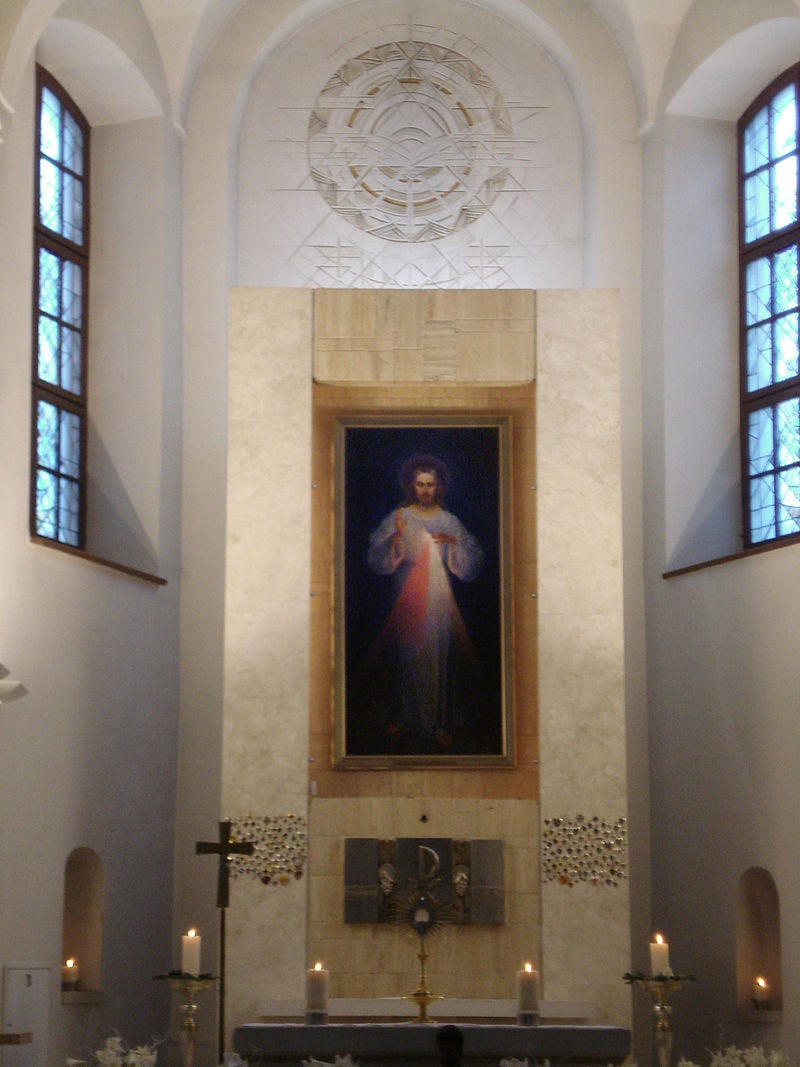The Easter letdown. It’s that feeling of spiritual dryness that comes with the celebration of the Resurrection. Lent is intense, spiritually and sometimes physically, depending on the disciplines you’ve taken on. But at Easter, all is fulfilled. Your special almsgiving and penances come to an end. You might lapse in the additions you’ve made to your prayer life.
But Christ is risen! It’s all good! The whole point is to indulge in celebration! We are not Puritans or iconoclasts, denying the physical or corporal manifestations of the spiritual life. When we celebrate, we celebrate.
And yet the pleasures—even the genuine spiritual pleasures—of the Easter season often don’t feel as intense and meaningful as the deprivations and disciplines of Lent. I really don’t know if this is natural and good, or somehow disordered. Perhaps, while fasting and feasting are both good in their proper times and proportions, the former is necessarily more spiritually fruitful, as we turn our attention away from the corporal and toward the spiritual. But perhaps a spirituality that is more “fulfilled” by sorrow and apprehension than by joy and celebration is somehow stunted? I don’t have an easy answer.
Easter is more complicated, even awkward, than it might seem. And wasn’t it just so for the Apostles? Even in the forty days Christ walked among them, they largely went about their regular business or, as in this Sunday’s Gospel, skulked around trying to avoid trouble. Even in those apparently halcyon days there was a kind of awkwardness—which was only relieved at Pentecost.
Like the Apostles in those forty days, we know Christ is risen, but we don’t always feel His presence. All is accomplished! The divine plan has been fulfilled! And now we go back to business, after cleaning up the baskets and eating an uncomfortable amount of chocolate. The feeling of Easter doesn’t match the reality we claim to affirm.
Let’s use this time, just as the liturgies of this season invite us to, not just to look back on the fulfillment of Easter but forward to the next steps: Ascension and Pentecost. Christ’s work may be done, but ours continues.
These Seven Days
…in the Ordinary Form
It is the Second Sunday of Easter, known as Divine Mercy Sunday. The readings are Acts 5:12-16, Revelation 1:9-11a, 12-13, 17-19, and John 20:19-31, which is the story of Doubting Thomas.
Gregory the Great says of the St. Thomas story:
But when the Apostle says, “Faith is the substance of things hoped for, the evidence of things not seen,” (Heb. 11:1) it is plain that things which are seen, are objects not of faith, but of knowledge. Why then is it said to Thomas who saw and touched, Because thou hast seen Me, thou hast believed? Because he saw one thing, believed another; saw the man, confessed the God. But what follows is very gladdening; Blessed are they that have not seen, and yet have believed. In which sentence we are specially included, who have not seen Him with the eye, but retain Him in the mind, provided we only develop our faith in good works. For he only really believes, who practices what he believes.
The words of Thomas upon seeing and touching Christ, “my Lord and my God,” have also been passed down as a pious tradition to be said silently during the Elevation of the Blessed Sacrament during Mass. While I cannot find an authoritative document, several sources attest (with citations) that Pope St. Pius X attached a partial indulgence of seven years and seven quarantines (40 days) to this devotion.

Perhaps the most famous image of St. Thomas is this striking and somewhat lurid depiction by Caravaggio.
As Divine Mercy Sunday, this Sunday also commemorates the devotions of St. Faustina Kowalska. The Divine Mercy has developed into an entire industry of devotional practices, including the meditative Divine Mercy Chaplet, and religious communities, such as the Sisters of Merciful Jesus in my city, that would be too numerous to list . It is perhaps the most successful and spiritually fruitful new devotion of the past century.

The original Divine Mercy image, more staid and less dreamy than its most popular reproductions, rests permanently in this chapel in Vilnius, Lithuania.
Wednesday, May 1, is the Feast of St. Joseph the Worker. There is no denying that the liturgical is political, and rarely is this more evident than this feast, instituted in 1955 by Pope Pius XII as a kind of counter-programming to May Day, which had itself been co-opted as the communist International Workers Day. The commemoration celebrates the value the Church places on the hard life of the worker in the person of one of her most precious saints.
Rather than dwelling on the political, however, let’s notice how the feast is a rare opportunity in the calendar to consider the hidden family life of Jesus. St. Joseph had a workshop; he had tools; he had clients. And surely Christ supported Joseph in this vocation, as any boy would have helped his father. John Everett Millais’s Christ in the House of His Parents portrays the roughness of this life in a way that was shocking to nineteenth-century audiences:
…in the Extraordinary Form
It is the First Sunday after Easter, or Low Sunday. The Epistle is 1 John 5:4-10 and the Gospel is the same as in the Ordinary Form: John 20:19-31. The Catholic Encyclopedia indicates:
The origin of the name [Low Sunday] is uncertain, but it is apparently intended to indicate the contrast between it and the great Easter festival immediately preceding, and also, perhaps, to signify that, being the Octave Day of Easter, it was considered part of that feast, though in a lower degree.

The reading from the First Letter of John brings to mind the Divine Mercy image:
This is he who came by water and blood, Jesus Christ, not with the water only but with the water and the blood. (5:6)
The Haydock commentary, referencing the work of Robert Witham, gives this gloss:
The sense seems to be, by water, with which he ordered every one to be baptized and made Christians; secondly, by his blood shed on the cross for our redemption.
The collect exhorts us to bring the joy and the spiritual fruitfulness of this season with us throughout the year:
Praesta, quaesumus, omnipotens Deus: ut, qui paschalia festa peregimus; haec te largiente, moribus et vita teneamus.
Grant, we beseech Thee, Almighty God, that we who have completed the Easter holy days, may, through Thy imparting, retain these effects in our ways and our life.
It’s easy to come crashing down from the spiritual and emotional highs of Lent and Easter. This simple prayer invites us to think of this season as a spiritual annuity rather than a lump sum, something we can continue to draw from in the coming weeks and months. If we are to “retain these effect,” though, it won’t be through our own efforts, but “through Thy imparting.”
Tuesday, April 30 is the traditional feast of St. Catherine of Siena (the feast was moved up one day in the 1969 calendar). A writer, mystic, reformer, and diplomat, Catherine is one of the most revered and remarkable saints not only of her era, but in Christian history.
Her mystical experiences have become some of the more popular non-Biblical subjects of religious art, especially her mystic marriage, which parallels that of another great Catherine, the fourth century Alexandrian.

Catherines of Alexandria (left) and Siena portrayed together by Ambrogio Bergognone.
While Catherine’s original account has at times be bowdlerized, she reported that the wedding ring she received from Christ was his foreskin. Depictions of the vision often portray Jesus as a child.

This late-fifteenth century depiction is by Lorenzo d'Alessandro da Sanseverino. It resides at the National Gallery in London.
St. Catherine’s mystical tour of Heaven, Hell, and Purgatory—an experiential analogue to Dante’s Divine Comedy, written half a century earlier—has also inspired artists.

This anonymous portrayal of the saint being accosted by demons is installed in Warsaw.
Those Seven Days…
…in Catholic Twitter

This newsletter’s favorite liberal Catholic theologian comes down hard (and justly so) against brands’ cutesy usage of memes:


Kevin takes down another liberal shibboleth:


A trad priest plays a trad sport (you might think baseball is the trad sport, but you probably haven’t heard Canadian hockey commentary, which is so nostalgic even I blush):
And Fr. Schrenk finds an example of that Rust Belt staple—a beautiful and grand and poetic church in a run-down neighborhood:
Bonus: These words come from an inscription of the doors of the ecstatic Milan Cathedral:

…in the Content Mines
Philip Jeffrey reviews a book that provides the historic basis for a theoretical point that has made sense to me for a long time: The mainstreaming of gay and lesbian culture in America is much more a product of consumer capitalism than it is of “the left.”
I’m glad that the president of the Catholic University of America is glad that the students voted to block pornography on the campus WiFi. But let me ask: Why was it allowed to begin with, and why did the students have to take the initiative to ban it?
Leah Libresco’s moving review of a film about Jean Vanier’s L’Arche communities is not from the last week, but is relevant and important reading on the news of Vanier’s declining health.
And Constance Hull writes about the constant battle to grow in holiness, from the poignant perspective of a mother guiding a child who sometimes struggles to be good—even though she desperately wants to be good.
Feedback, &c.
Did I miss something important? Get something wrong? Do you have ideas for how to improve These Seven Days? Drop me a line at tsd.brandonmcg@gmail.com. This is a work in progress, and your feedback will help to make it the best it can be.
And if you enjoyed this, please forward it along to friends. Make sure you subscribe so you don’t miss a week of These Seven Days.






